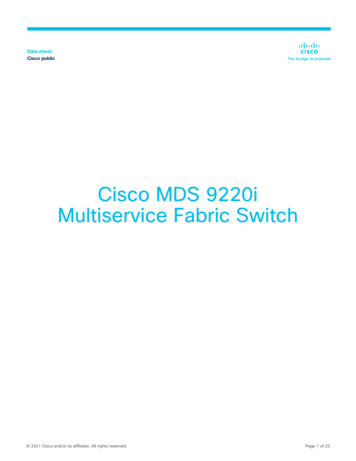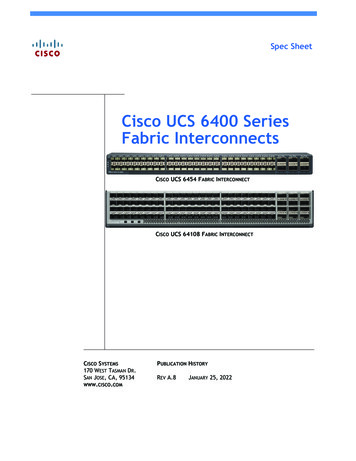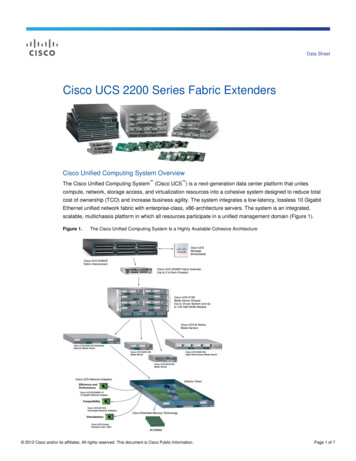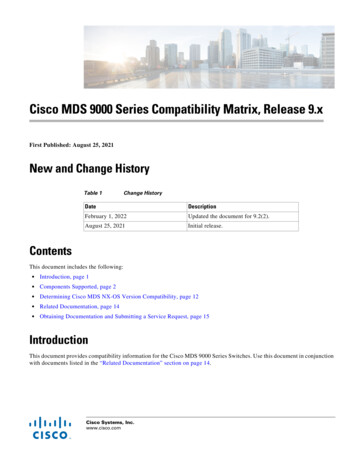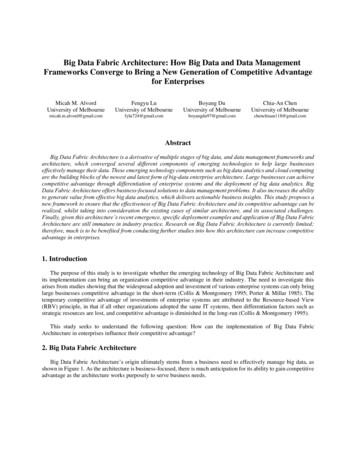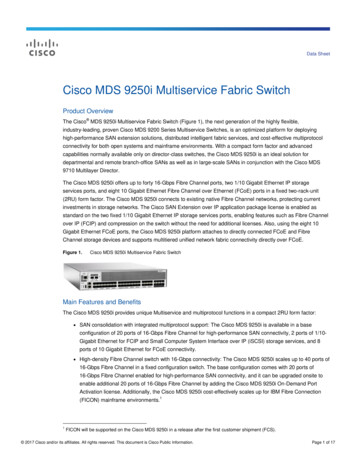
Transcription
Data SheetCisco MDS 9250i Multiservice Fabric SwitchProduct OverviewThe Cisco MDS 9250i Multiservice Fabric Switch (Figure 1), the next generation of the highly flexible,industry-leading, proven Cisco MDS 9200 Series Multiservice Switches, is an optimized platform for deployinghigh-performance SAN extension solutions, distributed intelligent fabric services, and cost-effective multiprotocolconnectivity for both open systems and mainframe environments. With a compact form factor and advancedcapabilities normally available only on director-class switches, the Cisco MDS 9250i is an ideal solution fordepartmental and remote branch-office SANs as well as in large-scale SANs in conjunction with the Cisco MDS9710 Multilayer Director.The Cisco MDS 9250i offers up to forty 16-Gbps Fibre Channel ports, two 1/10 Gigabit Ethernet IP storageservices ports, and eight 10 Gigabit Ethernet Fibre Channel over Ethernet (FCoE) ports in a fixed two-rack-unit(2RU) form factor. The Cisco MDS 9250i connects to existing native Fibre Channel networks, protecting currentinvestments in storage networks. The Cisco SAN Extension over IP application package license is enabled asstandard on the two fixed 1/10 Gigabit Ethernet IP storage services ports, enabling features such as Fibre Channelover IP (FCIP) and compression on the switch without the need for additional licenses. Also, using the eight 10Gigabit Ethernet FCoE ports, the Cisco MDS 9250i platform attaches to directly connected FCoE and FibreChannel storage devices and supports multitiered unified network fabric connectivity directly over FCoE.Figure 1.Cisco MDS 9250i Multiservice Fabric SwitchMain Features and BenefitsThe Cisco MDS 9250i provides unique Multiservice and multiprotocol functions in a compact 2RU form factor: SAN consolidation with integrated multiprotocol support: The Cisco MDS 9250i is available in a baseconfiguration of 20 ports of 16-Gbps Fibre Channel for high-performance SAN connectivity, 2 ports of 1/10Gigabit Ethernet for FCIP and Small Computer System Interface over IP (iSCSI) storage services, and 8ports of 10 Gigabit Ethernet for FCoE connectivity. High-density Fibre Channel switch with 16-Gbps connectivity: The Cisco MDS 9250i scales up to 40 ports of16-Gbps Fibre Channel in a fixed configuration switch. The base configuration comes with 20 ports of16-Gbps Fibre Channel enabled for high-performance SAN connectivity, and it can be upgraded onsite toenable additional 20 ports of 16-Gbps Fibre Channel by adding the Cisco MDS 9250i On-Demand PortActivation license. Additionally, the Cisco MDS 9250i cost-effectively scales up for IBM Fibre Connection(FICON) mainframe environments.11FICON will be supported on the Cisco MDS 9250i in a release after the first customer shipment (FCS). 2017 Cisco and/or its affiliates. All rights reserved. This document is Cisco Public Information.Page 1 of 17
Intelligent application services engine: The Cisco MDS 9250i includes as standard a single applicationservices engine that enables the included Cisco SAN Extension over IP software solution package to run onthe two fixed 1/10 Gigabit Ethernet storage services ports. The Cisco SAN Extension over IP packageprovides an integrated, cost-effective, and reliable business-continuance solution that uses IP infrastructureby offering FCIP for remote SAN extension, along with a variety of advanced features to optimize theperformance and manageability of FCIP links. Hardware-based virtual fabric isolation with virtual SANs (VSANs) and Fibre Channel routing with InterVSAN Routing (IVR): VSANs and IVR enable deployment of large-scale multisite and heterogeneous SANtopologies. Integration into port-level hardware allows any port in a system or in a fabric to be partitionedinto any VSAN. Included in the optional Cisco MDS 9000 Enterprise advanced software package, IVRprovides line-rate routing between any of the ports in a system or in a fabric without the need for externalrouting appliances. Remote SAN extension with high-performance FCIP: Simplifies data protection and business continuance strategies by enabling backup, remote replication,and other disaster-recovery services over WAN distances using open-standards FCIP tunneling. Optimizes utilization of WAN resources for backup and replication by enabling hardware-basedcompression, hardware-based encryption, FCIP write acceleration, and FCIP tape read and writeacceleration; up to 16 virtual Inter-Switch Link (ISL) connections are provided on the two 1/10 GigabitEthernet ports through tunneling. Preserves Cisco MDS 9000 Family enhanced capabilities, including VSANs, IVR, advanced trafficmanagement, and network security across remote connections. Cost-effective iSCSI connectivity to Ethernet-attached servers: Extends the benefits of Fibre Channel SAN-based storage to Ethernet-attached servers at a lower costthan is possible using Fibre Channel interconnect alone. Increases storage utilization and availability through consolidation of IP and Fibre Channel block storage. Through transparent operation, preserves the capability of existing storage management applications. Advanced FICON services2: The Cisco MDS 9250i will support FICON environments, including cascadedFICON fabrics, VSAN-enabled intermix of mainframe and open systems environments, and N-port IDvirtualization (NPIV) for mainframe Linux partitions. IBM Control Unit Port (CUP) support enables in-bandmanagement of Cisco MDS 9200 Series switches from the mainframe management console. FICON tapeacceleration reduces latency effects for FICON channel extension over FCIP for FICON tape read and writeoperations to mainframe physical or virtual tape. This feature is sometimes referred to as tape pipelining.The Cisco MDS 9250i will also support the IBM Extended Remote Copy (XRC)3 Acceleration feature thatenables acceleration of dynamic updates for IBM z/OS Global Mirror, formerly known as XRC. Cisco Data Mobility Manager (DMM) as a distributed fabric service: Cisco DMM is a fabric-based datamigration solution that transfers block data nondisruptively across heterogeneous storage volumes andacross distances, whether the host is online or offline.23FICON will be supported on the Cisco MDS 9250i in a post-FCS release.XRC will be supported on the Cisco MDS 9250i in a post-FCS release. 2017 Cisco and/or its affiliates. All rights reserved. This document is Cisco Public Information.Page 2 of 17
Platform for intelligent fabric applications: The Cisco MDS 9250i provides an open platform that delivers theintelligence and advanced features required to make multilayer intelligent SANs a reality, includinghardware-enabled innovations to host or accelerate applications for data migration, storage backup, anddata replication. Hosting or accelerating these applications in the network can dramatically improvescalability, availability, security, and manageability of the storage environment, resulting in increased utilityand lower total cost of ownership (TCO). In Service Software Upgrade (ISSU) for Fibre Channel interfaces: Cisco MDS 9250i promotes highserviceability by allowing Cisco MDS 9000 NX-OS Software to be upgraded while the Fibre Channel portsare carrying traffic. Intelligent network services: Cisco MDS 9250i uses VSAN technology for hardware-enforced, isolatedenvironments within a single physical fabric, access control lists (ACLs) for hardware-based intelligentframe processing, and advanced traffic management features such as fabric wide quality of service (QoS)to facilitate migration from SAN islands to enterprise wide storage networks. High-performance ISLs: Cisco MDS 9250i supports up to 16 Fibre Channel ISLs in a single PortChannel.Up to 253 buffer-to-buffer credits can be assigned to a single Fibre Channel port to extend storage networksover long distances. Comprehensive network security framework: The Cisco MDS 9250i supports RADIUS and TACACS ,Secure File Transfer Protocol (SFTP), Secure Shell (SSH) Protocol, Simple Network Management ProtocolVersion 3 (SNMPv3) implementing Advanced Encryption Standard (AES), VSANs, hardware-enforcedzoning, ACLs, and per-VSAN role-based access control (RBAC). Additionally, the 10 Gigabit Ethernet portsoffer IP Security (IPsec) authentication, data integrity, and hardware-assisted data encryption for FCIP andiSCSI. IP Version 6 (IPv6) capable: The Cisco MDS 9250i supports IPv6 as mandated by the U.S. Department ofDefense (DoD), Japan, and China. IPv6 support is provided for FCIP, iSCSI, and management traffic routedinband and out of band. FIPS compliance: The Cisco MDS 9250i will be FIPS 140-2 compliant as mandated by the U.S. federalgovernment.4 Sophisticated diagnostics: The Cisco MDS 9250i provides intelligent diagnostics, protocol decoding, andnetwork analysis tools as well as integrated Cisco Call Home capability for added reliability, faster problemresolution, and reduced service costs.VSANsVSANs are ideal for efficient, secure SAN consolidation, enabling more efficient storage network utilization bycreating hardware-based isolated environments with a single physical SAN fabric or switch. Each VSAN can bezoned as a typical SAN and maintains its own fabric services for added scalability and resilience. VSANs allow thecost of SAN infrastructure to be shared among more users, while helping ensure complete segregation of trafficand retaining independent control of configuration on a VSAN-by-VSAN basis.4FIPS compliance will be supported in a post-FCS release. 2017 Cisco and/or its affiliates. All rights reserved. This document is Cisco Public Information.Page 3 of 17
IVRIn another step toward deploying efficient, cost-effective, consolidated storage networks, the Cisco MDS 9250isupports IVR, the industry’s first routing function for Fibre Channel. IVR allows selective transfer of data betweenspecific initiators and targets on different VSANs while maintaining isolation of control traffic within each VSAN.With IVR, data can transit VSAN boundaries while maintaining control plane isolation, thereby maintaining fabricstability and availability. IVR is one of the feature enhancements provided with the Cisco MDS 9000 Enterpriseadvanced software package and eliminates the need for external routing appliances, greatly increasing routingscalability while delivering line-rate routing performance, simplifying management, and eliminating the challengesassociated with maintaining separate systems. Deploying IVR means lower total cost of SAN ownership.FCIP for Remote SAN ExtensionData distribution, data protection, and business continuance services are significant components of today’sinformation-centric businesses. The capability to efficiently replicate critical data on a global scale not only helpsensure a higher level of data protection for valuable corporate information, but also increases utilization of backupresources and lowers total cost of storage ownership. Building on Cisco expertise and knowledge of IP networks, the Cisco MDS 9250i switch uses openstandards FCIP to break the distance barrier of current Fibre Channel solutions, enabling interconnection ofSAN islands over extended distances. The Cisco MDS 9250i dramatically enhances hardware-based FCIP compression performance for bothhigh-bandwidth and low-bandwidth links, providing immediate cost savings for expensive WANinfrastructure. The Cisco MDS 9250i achieves up to a 43:1 compression ratio, with typical ratios of 4:1 to5:1 over a wide variety of data sources. The Cisco MDS 9250i supports hardware-based IPsec encryption for secure transmission of sensitive dataover extended distances. Hardware enablement of IPsec helps ensure high throughput. Used together,hardware-based compression and hardware-based encryption provide high-performance, highly secureSAN extension capabilities.I/O Accelerator ServicesThe Cisco MDS 9250i supports Cisco MDS 9000 I/O Acceleration (IOA) services, an advanced software packagethat can significantly improve application performance when storage traffic is extended across long distances.When Fibre Channel and FCIP write acceleration are enabled, WAN throughput is optimized through reducedlatency for command acknowledgments. Similarly, the Cisco MDS 9250i supports Fibre Channel and FCIP tapewrite acceleration, which allows operation at nearly full throughput over WAN links for remote tape backup andrestore operations.Cisco MDS 9000 IOA can be deployed in conjunction with disk data replication solutions to extend the distancebetween data centers or reduce the effects of latency. Cisco MDS 9000 IOA can also be used to enable remotetape backup and restore operations without significant throughput degradation. The main features of Cisco MDS9000 IOA include: Extension of acceleration service as a fabric service to any port in the fabric, regardless of where it isattached Fibre Channel write acceleration (FC-WA) and Fibre Channel tape acceleration (FC-TA) FCIP write acceleration (FCIP-WA) and FCIP tape acceleration (FCIP-TA) FCIP compression 2017 Cisco and/or its affiliates. All rights reserved. This document is Cisco Public Information.Page 4 of 17
High availability using PortChannels with acceleration over Fibre Channel and FCIP Unified solution for disk and tape I/O acceleration over metropolitan area networks (MANs) and WANs Speed-independent acceleration that accelerates 2/4/8/16-Gbps FC links and consolidates traffic over8/16 - Gigabit ISLsCisco DMMCisco DMM is an advanced software package comprising a fabric-based data migration solution that transfersblock data nondisruptively across heterogeneous storage volumes and across distances, whether the host is onlineor offline. This data center-class solution helps mitigate the challenges experienced in migrating data, such asdowntime, the need to add data migration software to servers, and the potential for data loss and corruption. Bysimply enabling the Cisco DMM feature on a Cisco MDS 9250i located anywhere in the SAN, data migration canbe configured without host agents, without rewiring, without affecting performance, and without downtime.Mainframe SupportThe Cisco MDS 9250i is mainframe ready and will support IBM zSeries FICON and Linux environments providedwith the Cisco MDS 9000 Mainframe advanced software package. To be qualified by IBM for attachment to allFICON-enabled devices in an IBM zSeries operating environment, Cisco MDS 9250i switches will support transportof the FICON protocol in both cascaded and noncascaded fabrics, as well as an intermix of FICON and opensystems Fibre Channel Protocol traffic on the same switch. VSANs simplify intermixing of SAN resources amongIBM z/OS, mainframe Linux, and open systems environments, enabling increased SAN utilization and simplifiedSAN management. VSAN-based intermix mode eliminates the uncertainty and instability often associated withzoning-based intermix techniques. VSANs also eliminate the possibility that a misconfiguration or componentfailure in one VSAN will affect operation in other VSANs. VSAN-based management access controls simplifypartitioning of SAN management responsibilities between mainframe and open systems environments, enhancingsecurity. FICON VSANs can be managed using the standard Cisco Prime Data Center Network Manager (DCNM),the Cisco command-line interface (CLI), or IBM CUP-enabled management tools, including SA/390, ResourceMeasurement Facility (RMF), and Dynamic Channel Path Management (DCM).The Cisco MDS 9000 Mainframe package is required for all Cisco MDS 9250i integrated FICON channel extensionfeatures. In combination with SAN extension capabilities, it enables FICON tape read and write acceleration. Incombination with SAN extension and the Cisco MDS 9000 XRC Acceleration package, it enables acceleration ofIBM z/OS Global Mirror (XRC) dynamic updates.Advanced Traffic ManagementThe following advanced traffic-management capabilities are integrated as standard on the Cisco MDS 9250i: Virtual output queue (VOQ): Helps ensure line-rate performance on each port, independent of traffic pattern,by eliminating head-of-line blocking. PortChannels: Allow users to aggregate up to 16 physical ISLs into a single logical bundle, providingoptimized bandwidth utilization across all links; the bundle can consist of any speed-matched ports from anymodule in the chassis, helping ensure that the bundle can remain active even in the event of a modulefailure. Fabric Shortest Path First (FSPF)-based multipathing: Provides the intelligence to load-balance across upto 16 equal-cost paths and, in the event of a switch failure, dynamically reroute traffic. Up to 253 buffer-to-buffer credits: Can be assigned to an individual port for optimal bandwidth utilizationacross long distances. 2017 Cisco and/or its affiliates. All rights reserved. This document is Cisco Public Information.Page 5 of 17
The following additional advanced traffic-management capabilities are available on the Cisco MDS 9250i with theoptional Cisco MDS 9000 Enterprise advanced software package to simplify deployment and optimization of largescale fabrics: QoS: Can be used to manage bandwidth and control latency, to prioritize critical traffic for specificapplications. IVR: Eliminates the need for external routing appliances, greatly increasing routing scalability whiledelivering line-rate routing performance, simplifying management, and eliminating the challengesassociated with maintaining separate systems. SCSI flow statistics: Collects logical unit number (LUN)-level SCSI flow statistics, including read, write, anderror statistics, for any combination of initiators and targets.Comprehensive Solution for Robust Network SecurityTo address the need for failure-proof security in storage networks, the Cisco MDS 9250i includes as standard anextensive security framework to protect highly sensitive data crossing today’s enterprise networks: Smart Zoning: When the Smart Zoning feature is enabled, Cisco MDS 9000 Family fabrics provision thehardware access control entries specified by the zone set more efficiently, avoiding the superfluous entriesthat would allow servers (initiators) to talk to other servers, or allow storage devices (targets) to talk to otherstorage devices. This feature makes larger zones with multiple initiators and multiple targets feasiblewithout excessive consumption of hardware resources. Thus, smart zones can correspond to applications,application clusters, hypervisor clusters, or other data center entities, saving the time that administratorspreviously spent creating many small zones, and enabling the automation of zoning tasks. Intelligent packet inspection is provided at the port level, including the application of ACLs for hardwareenforcement of zones, VSANs, and advanced port-security features. Extended zoning capabilities are provided to help ensure that LUNs can be accessed only by specific hosts(LUN zoning), to limit SCSI read commands for a certain zone (read-only zoning), and to restrict broadcaststo only selected zones (broadcast zones).The following additional advanced security-management capabilities are available on the Cisco MDS 9250i with theCisco MDS 9000 Enterprise advanced software package to further help ensure the security of large-scale fabrics: Switch-to-switch and host-to-switch authentication helps eliminate disruptions that may occur because ofunauthorized devices connecting to a large enterprise fabric. Port security locks down the mapping of an entity to a switch port to help ensure that SAN security is notcompromised by connection of unauthorized devices to a switch port. VSAN-based access control allows customers to define roles in which the scope of the roles is limited tocertain VSANs. FC-SP provides switch-switch and host-switch Diffie-Hellman Challenge Handshake Authentication Protocol(DH-CHAP) authentication supporting RADIUS and TACACS to help ensure that only authorized devicesaccess protected storage networks. Comprehensive IPsec protocol suite delivers secure authentication, data integrity, and hardware-basedencryption for both FCIP and iSCSI deployments. Digital certificates are issued by a trusted third party and are used as electronic passports to prove theidentity of certificate owners. 2017 Cisco and/or its affiliates. All rights reserved. This document is Cisco Public Information.Page 6 of 17
Fabric binding for open systems helps ensure that the ISLs are enabled between only switches that havebeen authorized in the fabric binding configuration.Advanced Diagnostics and Troubleshooting ToolsManagement of large-scale storage networks requires proactive diagnostics, tools to verify connectivity and routelatency, and mechanisms for capturing and analyzing traffic. The Cisco MDS 9000 Family integrates the industry’smost advanced analysis and diagnostic tools, which are included as standard on the Cisco MDS 9250i. The poweron self-test (POST) and Cisco Generic Online Diagnostics (GOLD) provide proactive health monitoring. The CiscoMDS 9250i implements diagnostic capabilities such as Fibre Channel traceroute to identify the exact path andtiming of flows, and Switched Port Analyzer (SPAN) to intelligently capture network traffic. After traffic has beencaptured, it can be analyzed with Cisco Fabric Analyzer, an embedded Fibre Channel analyzer. Comprehensiveport-based and flow-based statistics facilitate sophisticated performance analysis and service-level agreement(SLA) accounting. With the Cisco MDS 9000 Family, Cisco delivers a comprehensive tool set for troubleshootingand analysis of storage networks.Ease of ManagementTo meet the needs of all users, the Cisco MDS 9250i provides three principal modes of management: the CiscoMDS 9000 Family CLI, Cisco Prime DCNM, and integration with third-party storage management tools.The Cisco MDS9250i presents a consistent, logical CLI. Adhering to the syntax of the widely known Cisco IOS Software CLI, the Cisco MDS 9000 Family CLI is easy to learn and delivers broad management capabilities. TheCisco MDS 9000 Family CLI is an extremely efficient and direct interface designed to provide optimal capabilities toadministrators in enterprise environments.Cisco Prime Data Center Network Manager (DCNM) is the network’s industry’s first converged SAN and LANmanagement solution5. Cisco Prime DCNM can is able to manage all NX-OS based devices, including the CiscoMDS 9000 Family and Cisco Nexus Family products. The intuitive graphical user interface simplifies day-to-dayoperations of Cisco unified fabrics in today’s highly virtualized data center environments.The main functions supported by Cisco Prime DCNM include:5 Monitoring of events and performance historically and at scale Wizard- and template-based provisioning of technologies and services based on Cisco NX-OS Dynamic topology views with extended visibility into virtual infrastructure Resource management through trend analysis of inventory and performance Rule-based event notification and filtering Role Based Access Control, providing separation between the network and storage teamsThe earlier version of Cisco Prime DCNM was the Cisco Fabric Manager 2017 Cisco and/or its affiliates. All rights reserved. This document is Cisco Public Information.Page 7 of 17
The solution is designed to scale to large enterprise deployments through scale-out server architecture withautomated failover capability. These capabilities provide a resilient management system that centralizesinfrastructure and path monitoring across geographically dispersed data centers. Cisco Prime DCNM basemanagement functions are available at no charge; advanced features are unlocked with the license.The Cisco Prime DCNM application can be installed on Linux and Microsoft Windows operating systems andsupports both PostgreSQL and Oracle databases.Advanced Software PackagesThe Cisco MDS 9250i can be further enhanced through additional optional licensed software packages that offeradvanced intelligence and functions (summarized in Tables 1 and 2). Currently available software packagesinclude the following: Cisco MDS 9000 Enterprise package: This package includes a set of traffic engineering and advancedsecurity features, such as, IVR, QoS, switch-to-switch and host-to-switch authentication, LUN zoning, andread-only zones, that are recommended for enterprise SANs. Cisco Prime DCNM License: This is the licensed version of Cisco Prime DCNM that provides serverfederation, historical performance monitoring for network traffic hot-spot analysis, centralized managementservices, and advanced application integration. Cisco MDS 9000 DMM package: This package on the Cisco MDS 9250i enables Cisco DMM to performfabric-based data migration that transfers block data nondisruptively across heterogeneous storagevolumes and across distances, regardless of whether the host is online or offline. Cisco MDS 9000 IOA Services package: The Cisco MDS 9250i supports IOA services, an advancedsoftware package that can significantly improve application performance when storage traffic is extendedacross long distances. When Fibre Channel and FCIP write acceleration is enabled, WAN throughput isoptimized through reduced latency for command acknowledgments. Cisco MDS 9000 Mainframe package: This package is a comprehensive collection of features required forusing the Cisco MDS 9500 Series and MDS 9200 Series switches in mainframe storage networks, includingFICON protocol, FICON tape acceleration (read and write), CUP management, switch cascading, fabricbinding, and intermixing.6 Cisco MDS 9000 XRC Acceleration package: In conjunction with the SAN Extension over IP and Mainframepackages, this package provides acceleration (channel extension) over IP for the IBM z/OS Global Mirrorreplication solution, reducing the effects of latency at distances of up to 20,000 km.7Table 1.67Advanced Software Packages Not Requiring Application Services EngineAdvanced Software Packages Not Requiring Application Services EngineIncluded or OptionalCisco Prime DCNM base versionIncludedCisco Prime DCNM licensed versionOptionalCisco MDS 9000 EnterpriseOptionalCisco MDS 9000 MainframeOptionalCisco MDS 9000 XRC AccelerationOptional1FICON will be supported on the Cisco MDS 9250i in a post-FCS release.XRC will be supported on the Cisco MDS 9250i in a post-FCS release. 2017 Cisco and/or its affiliates. All rights reserved. This document is Cisco Public Information.Page 8 of 17
Table 2.Advanced Software Packages Requiring Application Services EngineAdvanced Software Packages Requiring Application Services EngineIncluded or OptionalCisco MDS 9000 SAN Extension over IPIncludedCisco MDS 9000 IOA ServicesOptionalCisco DMMOptionalNotes:1XRC requires a Mainframe license. FICON and XRC will be supported on the Cisco MDS 9250i in a post-FCS release.Product SpecificationsTable 3 lists the product specifications for the Cisco MDS 9250i.Table 3.Product SpecificationsFeatureDescriptionProduct compatibilityCisco MDS 9000 FamilySoftware compatibility Cisco MDS 9000 NX-OS Release 6.2(2) or later Cisco MDS 9000 NX-OS Release 6.2(2) or later for Cisco Prime DCNM supportProtocols Fibre Channel standards FC-PH, Revision 4.3 (ANSI INCITS 230-1994)FC-PH, Amendment 1 (ANSI INCITS 230-1994/AM1-1996)FC-PH, Amendment 2 (ANSI INCITS 230-1994/AM2-1999)FC-PH-2, Revision 7.4 (ANSI INCITS 297-1997)FC-PH-3, Revision 9.4 (ANSI INCITS 303-1998)FC-PI, Revision 13 (ANSI INCITS 352-2002)FC-PI-2, Revision 10 (ANSI INCITS 404-2006)FC-PI-3, Revision 4 (ANSI INCITS 460-2011)FC-PI-4, Revision 8 (ANSI INCITS 450-2008)FC-PI-5, Revision 6 (ANSI INCITS 479-2011)FC-FS, Revision 1.9 (ANSI INCITS 373-2003)FC-FS-2, Revision 1.01 (ANSI INCITS 424-2007)FC-FS-2, Amendment 1 (ANSI INCITS 424-2007/AM1-2007)FC-FS-3, Revision 1.11 (ANSI INCITS 470-2011)FC-LS, Revision 1.62 (ANSI INCITS 433-2007)FC-LS-2, Revision 2.21 (ANSI INCITS 477-2011)FC-SW-2, Revision 5.3 (ANSI INCITS 355-2001)FC-SW-3, Revision 6.6 (ANSI INCITS 384-2004)FC-SW-4, Revision 7.5 (ANSI INCITS 418-2006)FC-SW-5, Revision 8.5 (ANSI INCITS 461-2010)FC-GS-3, Revision 7.01 (ANSI INCITS 348-2001)FC-GS-4, Revision 7.91 (ANSI INCITS 387-2004)FC-GS-5, Revision 8.51 (ANSI INCITS 427-2007)FC-GS-6, Revision 9.4 (ANSI INCITS 463-2010)FCP, Revision 12 (ANSI INCITS 269-1996)FCP-2, Revision 8 (ANSI INCITS 350-2003)FCP-3, Revision 4 (ANSI INCITS 416-2006)FCP-4, Revision 2b (ANSI INCITS 481-2011)FC-SB-2, Revision 2.1 (ANSI INCITS 349-2001)FC-SB-3, Revision 1.6 (ANSI INCITS 374-2003)FC-SB-3, Amendment 1 (ANSI INCITS 374-2003/AM1-2007)FC-SB-4, Revision 3.0 (ANSI INCITS 466-2011)FC-BB-2, Revision 6.0 (ANSI INCITS 372-2003)FC-BB-3, Revision 6.8 (ANSI INCITS 414-2006) 2017 Cisco and/or its affiliates. All rights reserved. This document is Cisco Public Information.Page 9 of 17
FeatureDescription FC-BB-4, Revision 2.7 (ANSI INCITS 419-2008)FC-BB-5, Revision 2.0 (ANSI INCITS 462-2010)FC-VI, Revision 1.84 (ANSI INCITS 357-2002)FC-SP, Revision 1.8 (ANSI INCITS 426-2007)FC-SP-2, Revision 2.71 (ANSI INCITS 496-2012)FAIS, Revision 1.03 (ANSI INCITS 432-2007)FAIS-2, Revision 2.23 (ANSI INCITS 449-2008)FC-IFR, Revision 1.06 (ANSI INCITS 475-2011)FC-FLA, Revision 2.7 (INCITS TR-20-1998)FC-PLDA, Revision 2.1 (INCITS TR-19-1998)FC-Tape, Revision 1.17 (INCITS TR-24-1999)FC-MI, Revision 1.92 (INCITS TR-30-2002)FC-MI-2, Revision 2.6 (INCITS TR-39-2005)FC-MI-3, Revision 1.03 (INCITS TR-48-2012)FC-DA, Revision 3.1 (INCITS TR-36-2004)FC-DA-2, Revision 1.06 (INCITS TR-49-2012)FC-MSQS, Revision 3.2 (INCITS TR-46-2011)FC-AL, Revision 4.5 (ANSI/INCITS 272-1996)#FC-AL-2, Revision 7.0 (ANSI/INCITS 332-1999) #FC-AL-2, Amendment 1 (ANSI/INCITS 332-1999/AM1-2003) #FC-AL-2, Amendment 2 (ANSI/INCITS 332-1999/AM2-2006) # Fibre Channel classes of service: Class 2, Class 3, and Class F Fibre Channel standard port types: E, F, FL, and B Fibre Channel enhanced port types: SD, ST, and TE IP over Fibre Channel (RFC
enable additional 20 ports of 16-Gbps Fibre Channel by adding the Cisco MDS 9250i On-Demand Port Activation license. Additionally, the Cisco MDS 9250i cost-effectively scales up for IBM Fibre Connection (FICON) mainframe environments.1 1 FICON will be supported on the Cisco MDS 9250i in a release after the first customer shipment (FCS).



